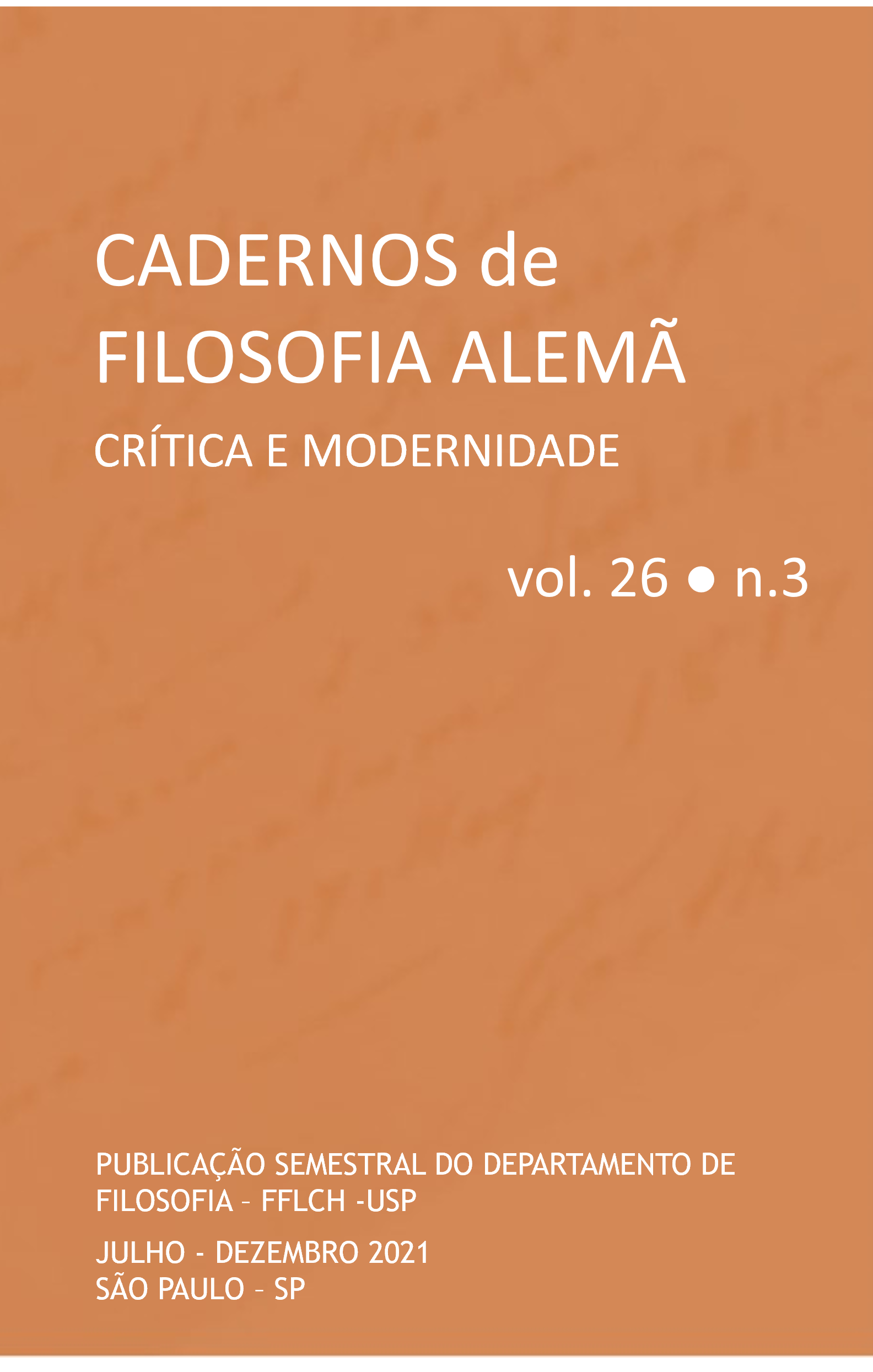A semelhança da música com a linguagem segundo Theodor Adorno: sentidos diferentes do conceito a partir da música tradicional e da nova música
DOI:
https://doi.org/10.11606/issn.2318-9800.v26i3p13-26Palavras-chave:
Adorno, Música tradicional, Nova música, Nexo de sentido, SemelhançaResumo
Este artigo investiga a concepção de semelhança da música com a linguagem na estética musical de Adorno. Partindo de uma descrição e fundamentação histórica do conceito, o objetivo principal deste artigo consiste na defesa de que o conceito se concebe de modo especifico na música tradicional (tonalidade), por um lado, e na nova música, por outro lado. Desse modo, argumentaremos que, apesar de a nova música ter se rebelado contra o conceito, ele permaneceria presente em sua estrutura, pois, ao fim, ele seria condição para a constituição de um elemento fundamental da música, a saber, o nexo de sentido.
Downloads
Referências
Adorno, T. (1997a). Das Altern der neuen Musik. In: _____. Gesammelte Schriften 14: Dissonanzen. Einleitung in die Musiksoziologie (pp. 143-167). Frankfurt am Main: Suhrkamp Verlag.
Adorno, T. (1997b). Die Funktion des Kontrapunkts in der neuen Musik. In: _____. Gesammelte Schriften 16: Musikalische Schriften I-III (pp. 145-169). Frankfurt am Main: Suhrkamp Verlag.
Adorno, T. (1997c). Form in der neuen Musik. In: _____. Gesammelte Schriften 16: Musikalische Schriften I-III (pp. 607-627). Frankfurt am Main: Suhrkamp Verlag.
Adorno, T. (1997d). Klassik, Romantik, Neue Musik. In: _____. Gesammelte Schriften 16: Musikalische Schriften I-III (pp. 126-144). Frankfurt am Main: Suhrkamp Verlag.
Adorno, T. (1997e). Kriterien der neuen Musik. In: _____. Gesammelte Schriften 16: Musikalische Schriften I-III (pp. 170-228). Frankfurt am Main: Suhrkamp Verlag.
Adorno, T. (1997f). Musik, Sprache und ihr Verhältnis im gegenwärtigen Komponieren. In: _____. Gesammelte Schriften 16: Musikalische Schriften I-III (pp. 649-664). Frankfurt am Main: Suhrkamp Verlag.
Adorno, T. (1997g). Neue Musik heute. In: _____. Gesammelte Schriften 18: Musikalische Schriften V (pp. 124-133). Frankfurt am Main: Suhrkamp Verlag.
Adorno, T. (1997h). Schiwierigkeiten: II. In der Auffassung neuer Musik. In: _____. Gesammelte Schriften 17: Musikalische Schriften IV (pp. 273-291). Frankfurt am Main: Suhrkamp Verlag.
Adorno, T. (1997i). Über das gegenwärtige Verhältnis von Philosophie und Musik. In: _____. Gesammelte Schriften 18: Musikalische Schriften V (pp. 149-176). Frankfurt am Main: Suhrkamp Verlag.
Adorno, T. (1997j). Über einige Relationen zwischen Musik und Malerei. In: _____. Gesammelte Schriften 16: Musikalische Schriften I-III (pp. 628-642). Frankfurt am Main: Suhrkamp Verlag.
Adorno, T. (1997k). Warum ist die neue Kunst so schwer verständlich? In: _____. Gesammelte Schriften 18: Musikalische Schriften V (pp.824-831). Frankfurt am Main: Suhrkamp Verlag.
Adorno, T. (1997l). Zum Verhältnis von Malerei und Musik heute. In: ______. Gesammelte Schriften 18: Musikalische Schriften V (pp. 140-148). Frankfurt am Main: Suhrkamp Verlag.
Adorno, T. (2001). Zu einer Theorie der musikalischen Reproduktion: Aufzeichnungen, ein Entwurf und zwei Schemata. Frankfurt am Main: Suhrkamp.
Adorno, T. (2008). Teoria Estética. Trad. Artur Morão. Lisboa: Edições 70.
Adorno, T. (2011). Filosofia da Nova Música. Trad. Magda França. São Paulo: Perspectiva.
Adorno, T. (2017). Introdução a Sociologia da Música: doze preleções teóricas. Trad. Fernando R. de Moraes Barros. 2ª ed. São Paulo: Editora Unesp.
Adorno, T. (2018a). Fragmento sobre Música e Linguagem. In: ______. Quase una Fantasia: Escritos Musicais II (pp. 35-42). Trad. Eduardo Socha. São Paulo: Editora Unesp.
Adorno, T. (2018b). Vers une musique informelle. In: ______. Quase una Fantasia: Escritos Musicais II (pp. 375-442). Trad. Eduardo Socha. São Paulo: Editora Unesp.
Barbosa, R. (2020). Zur Dialektik von Musik und Sprache: die Sprachähnlichkeit der Musik nach Adorno. Musik & Ästhetik, Bd 93, 42-57. URL: https://www. musikundaesthetik.de/article/99.120205/mu-24-1-42
Duarte, R. (2014). Sobre o conceito de ‘pseudomorfose’ em Theodor Adorno. In: ______. Varia aesthetica: ensaios sobre arte e sociedade (pp. 237-254). Belo Horizonte: Relicário.
Hindrichs, G. (2019). Der Fortschritt des Materials. In: Klein, R.; Kreuzer, J; MüllerDoohm, S. (Orgs.). Adorno-Handbuch (pp. 59-70). 2ª ed. Berlin: J.B. Metzler.
Hogh, P. (2020). Sprachähnlichkeit der Musik, Musikähnlichkeit der Sprache: eine Lücke in Adornos Musikästhetik. Musik & Ästhetik, Bd 93, 58–78. URL: https:// www.musikundaesthetik.de/article/99.120205/mu-24-1-58
Kreis, G. (2019). Der philosophische Kritik der musikalischen Werke. In: Klein, R.; Kreuzer, J; Müller-Doohm, S. (Orgs.). Adorno-Handbuch (pp. 85-96). 2ª ed. Berlin: J.B. Metzler.
Linke, C. (2019). Kritik der seriellen Musik. In: Klein, R.; Kreuzer, J; Müller-Doohm, S. (Orgs.). Adorno-Handbuch (pp. 206-213). 2ª ed. Berlin: J.B. Metzler.
Paddison, M. (1998). The Language-Character of Music. Some Motifs in Adorno. In: Klein, R.; Mahnkopf, C. (Orgs.). Mit den Ohren denken: Adornos Philosophie der Musik (pp. 71-91). Frankfurt am Main: Suhrkamp.
Schoenberg, A. (1996). Fundamentos da composição musical. Trad. Eduardo Seineman. São Paulo: Editora da Universidade de São Paulo.
Weber, M. (1978). Economy and Society: an outline of interpretative sociology. Ed. Guenther Roth e Claus Wittich. Berkeley, Los Angeles, London: University of California Press.
Downloads
Publicado
Edição
Seção
Licença
Copyright (c) 2021 Luis Filipe de Lima Andrade

Este trabalho está licenciado sob uma licença Creative Commons Attribution-NoDerivatives 4.0 International License.
As informações e conceitos emitidos em textos são de absoluta responsabilidade de seus autores.
Todos os artigos anteriores a 5 de julho de 2018 e posteriores a julho de 2021 estão licenciados sob uma licença CC BY-NC-ND, exceto os publicados entre as datas mencionadas, que estão sob a licença CC BY-NC-SA. A permissão para tradução por terceiros do material publicado sob a licença CC BY-NC-ND poderá ser obtida com o consentimento do autor ou autora.
Políticas de acesso aberto - Diadorim



